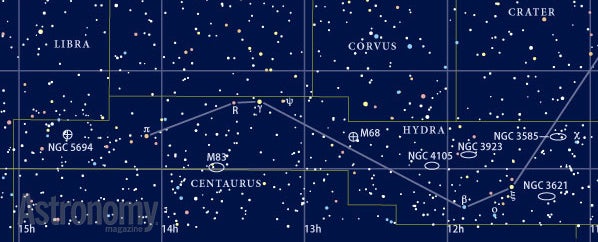Targets for April 12–19, 2012
Small telescope: The Lambda Centauri Cluster
Large telescope: The Frame Galaxy (NGC 3621)
Large telescope: Elliptical galaxy NGC 3640
Chicken, run!
This week’s small-telescope target is the Lambda (λ) Centauri Cluster in Centaurus, also known as Collinder 249 and Caldwell 100.
To locate this target, first find its namesake, magnitude 3.1 Lambda Centauri. Beginning with that star and running toward the southeast throughout this whole area is a huge open star cluster whose oval shape spans 65′ by 40′. And it’s bright. The cluster shines at magnitude 4.0. But this area contains a lot more than a star cluster.
Through a 4-inch telescope from a dark site, you’ll spot the ionized hydrogen (HII) region IC 2944 (often called the Running Chicken Nebula) concentrated around Lambda Centauri.
IC 2944 is famous for the dense, opaque dust clouds discovered by South African astronomer Andrew David Thackeray in 1950, now known as Thackeray’s Globules. Astronomers find such regions in areas of intense star formation. They appear as shadows against the background nebula, which lies 5,900 light-years away. Ultraviolet radiation from nearby, recently formed stars erodes the globules and may ultimately dissipate them.
You won’t see Thackeray’s Globules visually, but through an 8-inch telescope equipped with a low-power eyepiece and a nebula filter, the region of IC 2944 appears bright. Some sources list its magnitude as high as 4.8. Just 12′ southeast of this nebula lies another HII region, IC 2948. It appears larger but fainter than IC 2944.
I was framed
This week’s first large-scope object is the Frame Galaxy, otherwise known as spiral NGC 3621 in the constellation Hydra the Water Snake. It shines at magnitude 8.9 and measures 9.8′ by 4.6′.
This object lies 3.3° west-southwest of magnitude 3.5 Xi (ξ) Hydrae. The Frame appears twice as long as it is wide, oriented north-northwest to south-southeast.
The central area is wide and evenly illuminated. The halo, however, reveals mottling, which suggests spiral structure. Two 10th-magnitude stars lie at the southern edge of the galaxy.
NGC 3621’s common name has nothing to do with how the galaxy looks. Rather, Astronomy magazine Contributing Editor David H. Levy gave it this name because a parallelogram of stars surrounds it, making the galaxy appear “framed.” English astronomer Sir William Herschel also mentioned the stellar parallelogram around the time he discovered NGC 3621 in 1790.
Five for viewing
This week’s second large-telescope target is elliptical galaxy NGC 3640 in Leo the Lion. It glows at magnitude 10.3 and measures 4.0′ by 3.2′.
Point your telescope 2.8° south of magnitude 4.1 Sigma (σ) Leonis to find this object. If you observe through a 12-inch or larger scope from a dark site, then NGC 3640 begins a 0.4°-long, slightly ragged line of five galaxies that stretches to the south-southeast. In order after NGC 3640, they are magnitude 13.1 NGC 3641, magnitude 14.1 NGC 3643, magnitude 14.3 NGC 3647, and magnitude 14.2 NGC 3644.
NGC 3640 itself appears slightly oval in an east to west orientation. It has a broad, bright central region and a faint, but reasonably thick halo.
Expand your observing at Astronomy.com
StarDome
Check out Astronomy.com’s interactive StarDome to see an accurate map of your sky. This tool will help you locate this week’s targets.
The Sky this Week
Get a daily digest of celestial events coming soon to a sky near you.
Observing Talk
After you listen to the podcast and try to find the objects, be sure to share your observing experience with us by leaving a comment at the blog or in the Reader Forums.











